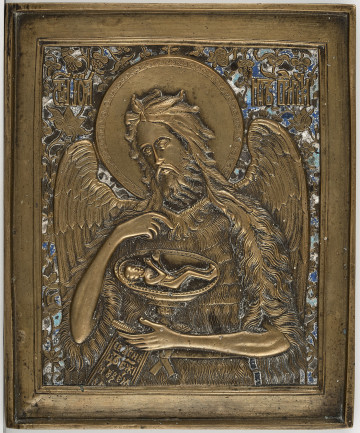
St. John the Baptist
20th century
Castle Museum in Łańcut
Part of the collection: Icons
St. Nicholas icon The presented depiction of St. Nicholas the Wonderworker is one of the numerous Russian examples of cast metal icons. With the adoption of Christianity, various objects of worship made their way from Byzantium to Rus. Among the imports were, among others, metal crafts made of bronze, brass, or silver. Over time, local foundries producing such items were established in the Principality of Kiev and, after its collapse, in Veliky Novgorod and then in Moscow. Initially, stone and clay moulds were used for their production; later, the process and technology were improved. The greatest breakthrough in casting art began in the second half of the 17th c. The reform, which was meant to adapt the liturgy and liturgical books of the Russian Orthodox Church to the current Greek ones, caused a schism, called the 'Raskol' in Russian. The adherents of the old Russian tradition who did not accept the reform were called the Old Believers or the Old Ritualists and eventually 'raskolniki'. Protecting themselves from the persecution of the state and the official Moscow Orthodox Church, they hid in hard-to-reach frontiers, creating their own communities. The Old Ritualists perfected the casting and decoration of metal objects of worship and brought it to high technical and artistic standards. To produce them, they used alloys of bronze, copper, brass, and silver, as well as ornamentation with coloured enamel and gilding. The models they had been developing in the Vygov workshops located in the north of Karelia since the 17th c. had been copied by numerous workshops in the 18th-19th c., until the start of the 20th c. The presented icon of St. Nicholas is one of many such products, see S.12796MŁ, S.12836MŁ, S.12866MŁ, S.12868MŁ. It is a so-called 'pendant' - on the back, it has a loop for stringing, so that the image could be worn on the body, e.g. around the neck. Teresa Bagińska-Żurawska https://orcid.org/0000-0002-9243-3967
Dimensions
height: 6.1 cm, width: 4.1 cm
Object type
Icons
Technique
gilding, cast, enamelling
Material
gold, bronze, varnish enamel
Creation time / dating
Creation / finding place
Owner
Castle Museum in Łańcut
Identification number
Location / status

20th century
Castle Museum in Łańcut

19th (?) century
Castle Museum in Łańcut

1800 — 1850
Castle Museum in Łańcut
DISCOVER this TOPIC
National Museum in Lublin
DISCOVER this PATH
Educational path